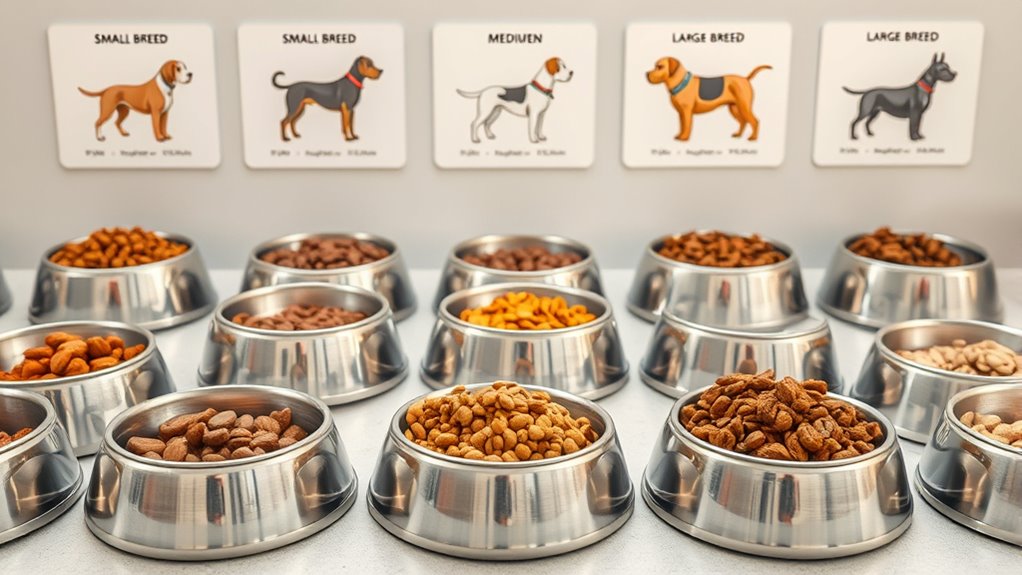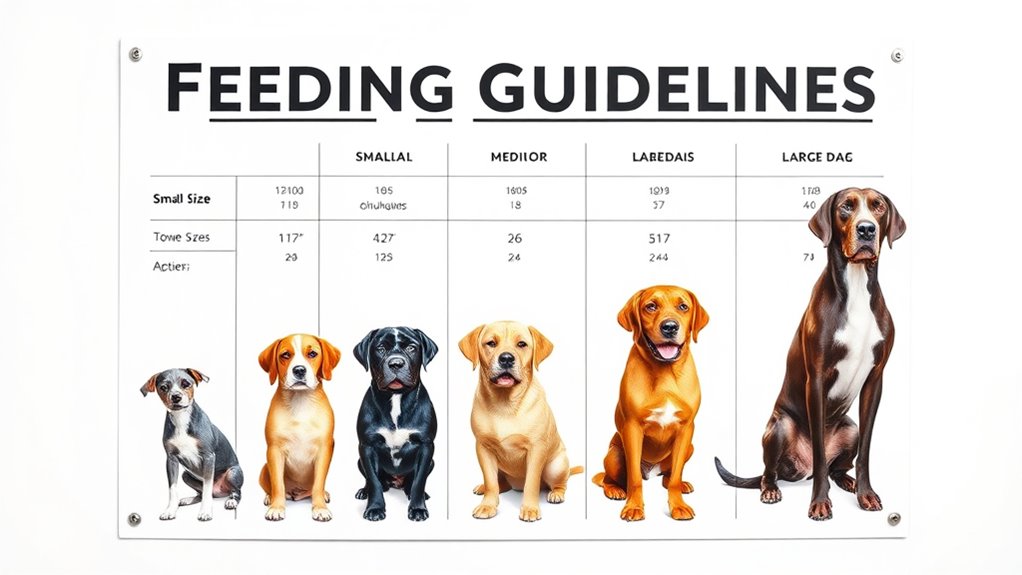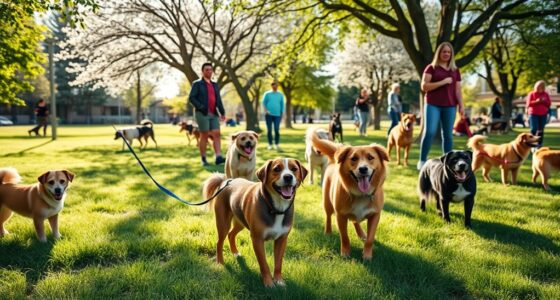To determine the right feeding guidelines for your dog, consider their size and breed, as these affect their daily calorie needs. Small breeds typically require less food than larger ones, but they may need more frequent meals to prevent hypoglycemia. Large breeds need a balanced diet to support joint health and prevent obesity, while specific breed traits may influence portion sizes. If you want to learn more about tailored feeding plans, continue exploring how to meet your dog’s unique nutritional needs.
Key Takeaways
- Use breed-specific feeding guides that consider the dog’s size, age, and activity level to determine appropriate portion sizes.
- Measure food accurately and adjust portions based on weight monitoring to prevent overfeeding or underfeeding.
- Select nutrient-dense ingredients appropriate for the dog’s breed and size, balancing proteins, carbs, fats, and vitamins.
- Incorporate regular exercise to complement dietary needs and maintain a healthy weight, especially for larger or more active breeds.
- Consult with a veterinarian or pet nutritionist for personalized feeding plans tailored to your dog’s breed and individual health requirements.

Feeding your dog the right amount of nutritious food is essential for their health and happiness. When it comes to managing your dog’s diet, especially if you’re considering homemade diets, understanding how to prevent issues like treating obesity is crucial. Many pet owners turn to homemade diets to ensure their dogs get fresh, high-quality ingredients, but without proper planning, this can lead to overfeeding and weight gain. To avoid this, you need to pay close attention to portion sizes and nutritional balance. A homemade diet should include a mix of proteins, carbohydrates, fats, and essential vitamins, tailored to your dog’s age, weight, and activity level. Consulting your vet or a pet nutritionist can help you craft a balanced plan that keeps your dog fit and healthy.
If your dog is prone to obesity, it’s vital to adjust their diet accordingly. Obesity not only shortens their lifespan but also increases the risk of health problems like diabetes, joint issues, and heart disease. To treat obesity effectively, focus on controlling calorie intake, choosing the right foods, and incorporating regular exercise into their routine. For homemade diets, this means measuring ingredients carefully and avoiding high-fat or calorie-dense treats. Instead, opt for low-calorie veggies like carrots, green beans, or cucumbers, which satisfy their need to chew and are low in calories. Remember, treats and snacks should make up no more than 10% of your dog’s daily caloric intake, especially if they’re overweight. Maintaining a consistent feeding schedule and portion control can make a significant difference in managing their weight.
When preparing homemade diets, it’s easy to overfeed, especially if you’re eager to give your dog variety. To prevent this, use a reliable feeding guide based on your dog’s weight and activity level, and stick to it. Regularly monitoring their weight and body condition score helps you adjust portions as needed. Treating obesity is a gradual process that requires patience and discipline, but with careful planning, your dog can enjoy nutritious meals without gaining excess weight. Incorporating physical activity alongside dietary changes amplifies your efforts and promotes a healthier, happier dog. Remember, homemade diets can be a wonderful way to bond with your pet while ensuring they get nutritious, wholesome food, but they demand attention to detail to prevent overfeeding and obesity. By being mindful of portion sizes and nutritional content, you’re setting your dog up for a long, healthy life filled with vitality and joy.
Frequently Asked Questions
How Often Should I Change My Dog’s Diet?
You should change your dog’s diet gradually, typically every 7 to 10 days, to maintain proper feeding frequency and diet consistency. Watch for signs of allergies or digestive issues, and consult your vet before making any major changes. Keep the transition smooth by mixing new food with the current diet, gradually increasing the new until your dog adapts. This approach helps prevent stomach upset and ensures a healthy, balanced diet.
Are Homemade Meals Safe for My Dog?
Homemade meals can be safe for your dog if you prioritize ingredients to avoid and guarantee balanced nutrition. Picture a vibrant bowl of wholesome ingredients versus a plate riddled with harmful substances. To keep your dog safe, avoid onions, garlic, grapes, and certain spices. Always consult a veterinarian or pet nutritionist to create a safe, nutritious homemade diet, avoiding potential hazards and assuring your dog’s health and happiness.
What Treats Are Healthy for Dogs?
You can give your dog healthy treats like homemade treats made with simple, natural ingredients, or opt for store-bought snacks labeled as healthy. Look for options with limited preservatives and artificial additives. Fresh fruits like apple slices or blueberries are also good choices, but avoid toxic foods like grapes or chocolate. Always consider your dog’s dietary needs, and give treats in moderation to support their health and happiness.
How Do I Manage a Picky Eater?
Think of your dog as a finicky artist, hesitant to try new flavors. To manage a picky eater, try picky eater strategies like offering small, tempting portions and mixing new foods with familiar favorites. Encourage diverse diets by rotating different proteins and treats, making mealtime exciting. Patience and consistency will help your pup develop a broader palate, turning mealtime into a delightful adventure rather than a chore.
When Should I Switch to Senior Dog Food?
You should switch to senior dog food around age 7 to 9, depending on your dog’s breed and size. Watch for signs of senior diet readiness, like decreased activity, weight gain, or health issues. These indicate your dog’s age-related nutritional needs are changing. Shift gradually over a week, mixing increasing amounts of senior food, to make certain your dog adapts comfortably and maintains good health.
Conclusion
Remember, tailoring your dog’s diet to their size and breed ensures they stay healthy and happy. For example, small breeds often require about 20 calories per pound, while larger breeds need around 15 calories. This difference highlights how vital personalized feeding is. By following these guidelines, you can prevent overfeeding or underfeeding, supporting your dog’s well-being. Keep these stats in mind, and you’ll provide the best possible care for your furry friend.










